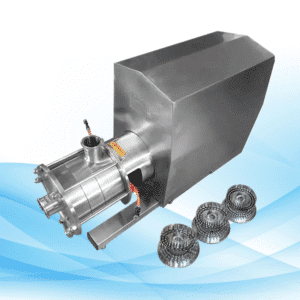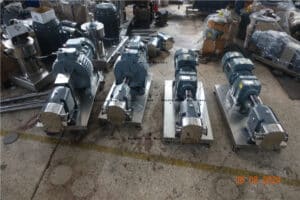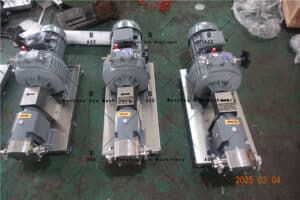Within the realm of industrial fluid handling
It is paramount to ensure the use of the appropriate type of pump for each aspect of the transfer. Non-positive displacement pumps are, in particular, important for such industries wherein the flow rate of the fluid is more important than keeping the pressure at a constant level. It is worthwhile to point out that there are two types of ‘non-positive displacement pumps, and positive displacement pumps, which every individual working with industrial pump systems must comprehend. In this guide, we will define what are non-positive displacement pumps, how do they function, what are their forms and use cases.
What Is a Non-Positive Displacement Pump?
A non-positive pressure pump is defined as a pump which achieves the movement of liquids by extension of energy to the working fluid, mainly by adding velocity. For a positive displacement pump, there is an element within its operation that causes the engagement of mater relative to a given volume, this is not true for a non-positive pump. With this incapacity of degree, some degree of pumping can be done through these types of pumps for a liquid. Indeed, it presents the possibility of delivering variable and uninterrupted flow, which is advantageous in cases where the need for pressure holding is not paramount.
Main characteristics of non-positive displacement pumps
- Flow rate is not constant and is determined by the resistance in the system
- Generally, employed in low applications
- Less lightweight as compared to the positive displacement pumps at high height work.
- Good for moving larger amounts of low viscosity fluids.
What is the operation of the Non-Positive Displacement Pumps?
The non-positive displacement pump works in such a way that mechanical energy is transformed to fluid’s velocity motion. An impeller or rotor within the pump is capable of spinning that applies velocity to the fluid. When the fluid is spinning, the fluid flows out from the casing of the pump and enters into the delivery line.
Non-positive displacement pumps are distinguished by the fact that they do not deliver a predetermined volume of liquid in a set time because of some means of pump actuation. In this case, the kinetic energy of the moving parts, not the pressure energy of the liquid, is transferred to the energy of movement of the liquid body. In this regard, the delivered volume is called variable, and it is in accordance with pressure and other factors affecting the system.
Working principle in summary:
- The impeller (or some other similar parts of the pump) rotates the fluid.
- Fluid is accelerated in its motion due to the impeller’s magnetic forces.
- The impeller rapidly fills with liquid and pushes it out through an outlet in the discharge of the pump.
- Flow rate is depending on the resistance available in the system, for example, changes in pressure.
Types of Non-Positive Displacement Pumps
There are other types of non-positive displacement pumps that are better suited for different uses. Some of the types that may be commonly encountered are:
Centrifugal Pumps

Centrifugal pumps are perhaps the best-known types of non-positive displacement pumps, as well as one of the most applied. They function by having a rotating impeller that does the movement of the fluid. When the impeller rotates, it also creates a center-pursuing force that pushes the fluid away from the inside of the pump towards the discharge outlet. Therefore, centrifugal pumps are used where the transfer of fluids, which have low viscosity, need to be done in large quantities.
Applications: Air conditioning systems, water treatment processes, chemical processing and pumping, irrigation.
Axial Flow Pumps
An axial flow pump is a pump that is used primarily to transmit fluids in the direction parallel to the shaft of the pump. These pumps, instead of a single screw as in shaft type pumps, use a jet or unidirectional rotary engine mounted on its axis to force the liquid on the pump’s axis. There are very low rises in pressure in the axial flow pump on large rotors and high flow rates.
Applications: Action flood control, circulation inside cyclone cooling towers, drainage systems.
Mixed Flow Pumps
They are self-explanatory; when it comes to mixed flow pumps, these characteristics can be termed as a bipolar design of utilities for centrifugal and axial flow pumps. In these types of hydraulic pumps, the fluid is aided both in radial and axial directions, making these pumps multifunctional. Most applications require rate and pressure simultaneously but at moderate levels.
Applications: Reclamation of water, agriculture, wastewater treatment, and dewatering.
Advantages of Non-Positive Displacement Pumps
Advantages of such types of pumps over positive displacement involve proper usage of each when necessary in the application context.
Simple Design
Non-positive displacement pumps, such as centrifugal pumps, have very few moving parts, hence less complication during maintenance throughout their lifespan.
High Flow Rate
High flow rate pumps are fitted with such capability and can disperse and circulate huge volumes of fluid in a short period.
Cost Effective
These pumps do not have complex structures and therefore do not incur a lot of expenses in purchasing and maintenance, generally unlike positive displacement pumps.
Low Maintenance
As non-positive displacement pumps have fewer parts and operate under low pressure, the frequency of maintenance schedules carried out on them is lower, which means that downtime also reduces.
Disadvantages of Non-Positive Displacement Pumps
Although non-positive displacement pumps can be effective in particular situations, some constraints exist:
Non-Uniform Flow at Elevated Pressure
Non-positive displacement pumps can be operated at varying output rates, but it is more difficult to achieve metered output when system pressure is raised. This feature makes them unsuitable for uses that call for precision in both the flow rate and pressure.
Restricted Viscosity Range
These pumps are inefficient for fluids of high viscosity, as the impeller or propeller will start losing efficiency in transferring kinetic energy to thicker liquids.
Leakage
Non-positive displacement pumps do not perform well under certain conditions. In particular, in some cases of non-positive displacement pumps, cavitation occurs.
Applications of Non-Positive Displacement Pumps
Factors that include their ability to discharge large volumes of fluid efficiently have made non-positive displacement pumps common in many industries. Some of the common applications include:
Water and Wastewater Management
Large centrifugal pumps are often found in water treatment plants and are used to transfer large volumes of water for treatment, purification, and distribution.
Turning Water into Rain
In agriculture, the axial flow pumps provide water to crops where large stretches of land need to be irrigated.
HVAC Systems
Non-positive displacement pumps are often employed in HVAC systems as water or coolant circulation pumps within buildings for efficient temperature control.
Marine Applications
These pumps are similarly employed in the marine sector for bilge pumping, cooling water systems, and ballast water.
How Non-Positive Displacement Pump Would Be Correctly Selected
The process of choosing the pump optimal for your application is influenced by:
Flow Rate Requirements
Large fluid-moving applications will require the use of a centrifugal or axial flow pump.
Pressure conditions
When constant pressure is not a crucial factor, a non-positive displacement pump is preferable because it is cheaper and more efficient.
Fluid Characteristics
Determine what type of fluid it is and its temperature as well as the non-positive displacement pumps are best suited to low viscosity liquids, whereas water or thin chemicals are also in this category.
Conclusion
Deep-well Non-positive displacement pumps form an integral part of several industries, as they are highly efficient in pumping fluids that are of high volumes but do not operate under constant pressure levels. Knowledge of the various non-positive displacement pump types, their working mechanisms, and the roles that they perform will guide you to make correct choices of pumps that you need and the tasks that you will be performing.
For everyone engrossed in water treatment, HVAC systems, or even agricultural irrigation, applications of non-positive displacement pumps are flexible and economical with regard to fluid management. When it comes to pumps, however, there is a remedy due to the fact that you can ensure maximal operational parameters and efficiency as well.


















